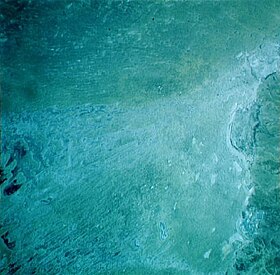Lake Callabonna
| Lake Callabonna | |
|---|---|

Lake Callabonna from space
|
|
|
Location in South Australia
|
|
| Location | Far North, South Australia |
| Coordinates | 29°43′S 140°05′E / 29.717°S 140.083°ECoordinates: 29°43′S 140°05′E / 29.717°S 140.083°E |
| Type | Salt lake |
| Basin countries | Australia |
| Designation |
Strzelecki Regional Reserve (only partially) Lake Callabonna Fossil Reserve |
| Surface area | 160 km2 (62 sq mi) |
Lake Callabonna is a dry salt lake with little to no vegetation located in the Far North region of South Australia. The 160-square-kilometre (62 sq mi) lake is situated approximately 120 kilometres (75 mi) southwest of Cameron Corner, the junction of South Australia, Queensland and New South Wales. It is also known as Lake Mulligan.
The lake is an important site for late fossils. It is within the extent of the Strzelecki Desert Lakes Important Bird Area, identified as such by BirdLife International because of its importance for waterbirds when holding water in the aftermath of floods.
The first pastoralists in the area were the Ragless brothers in 1881, who moved there from the northern Flinders Ranges, opening a sheep-run. In January 1892 Fred Ragless came across a number of giant skeletons embedded in the dry surface of the lake. An expedition partly funded by Sir Thomas Elder and E. C. Stirling, director of the South Australian Museum, was organised. After several visits, Stirling and A. H. C. Zietz collected a large number of diprotodon and dromornithidae skeletons. The area was designated a Fossil Reserve in 1901, and access is restricted.
The northern end of Lake Callabonna is within the boundary of the Strzelecki Regional Reserve.
Lake Callabonna is the location of a site where the “articulated skeletons of Diprotodon,” an extinct species of marsupial, were found in the late 19th century by the South Australian Museum. The site is considered to have “a very high palaeontological significance.” A fossil reserve was dedicated in 1901 under state law which currently in force as of 2002 as the Crown Lands Act 1929 with administrative responsibility lying with the South Australian Museum. In 2002, it pointed out that the lake received “negligible management effort as a Fossil Reserve under the Crown Lands Act 1929” and that proclamation under the National Parks and Wildlife Act 1972 may provide a higher level of protection against “degradation arising from uncontrolled access.” It was listed on the South Australian Heritage Register on 13 February 1997.
...
Wikipedia

